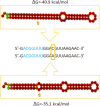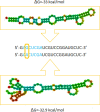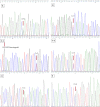Application of the targeted sequencing approach reveals the single nucleotide polymorphism (SNP) repertoire in microRNA genes in the pig genome
- PMID: 33972633
- PMCID: PMC8110958
- DOI: 10.1038/s41598-021-89363-5
Application of the targeted sequencing approach reveals the single nucleotide polymorphism (SNP) repertoire in microRNA genes in the pig genome
Abstract
MicroRNAs (miRNAs) are recognized as gene expression regulators, indirectly orchestrating a plethora of biological processes. Single nucleotide polymorphism (SNP), one of the most common genetic variations in the genome, is established to affect miRNA functioning and influence complex traits and diseases. SNPs in miRNAs have also been associated with important production traits in livestock. Thus, the aim of our study was to reveal the SNP variability of miRNA genes in the genome of the pig, which is a significant farm animal and large-mammal human model. To this end, we applied the targeted sequencing approach, enabling deep sequencing of specified genomic regions. As a result, 73 SNPs localized in 50 distinct pre-miRNAs were identified. In silico analysis revealed that many of the identified SNPs influenced the structure and energy of the hairpin precursors. Moreover, SNPs localized in the seed regions were shown to alter targeted genes and, as a result, enrich different biological pathways. The obtained results corroborate a significant impact of SNPs on the miRNA processing and broaden the state of knowledge in the field of animal genomics. We also report the targeted sequencing approach to be a promising alternative for the whole genome sequencing in miRNA genes focused studies.
Conflict of interest statement
The authors declare no competing interests.
Figures









Similar articles
-
Genome-wide in silico screening for microRNA genetic variability in livestock species.Anim Genet. 2013 Dec;44(6):669-77. doi: 10.1111/age.12072. Epub 2013 Jul 19. Anim Genet. 2013. PMID: 23865691
-
In silico screening of the chicken genome for overlaps between genomic regions: microRNA genes, coding and non-coding transcriptional units, QTL, and genetic variations.Chromosome Res. 2016 May;24(2):225-30. doi: 10.1007/s10577-016-9517-9. Epub 2016 Jan 22. Chromosome Res. 2016. PMID: 26800695
-
Comprehensive analysis of the impact of SNPs and CNVs on human microRNAs and their regulatory genes.RNA Biol. 2009 Sep-Oct;6(4):412-25. doi: 10.4161/rna.6.4.8830. Epub 2009 Sep 23. RNA Biol. 2009. PMID: 19458495 Free PMC article.
-
microRNA single polynucleotide polymorphism influences on microRNA biogenesis and mRNA target specificity.Gene. 2018 Jan 15;640:66-72. doi: 10.1016/j.gene.2017.10.021. Epub 2017 Oct 13. Gene. 2018. PMID: 29032146 Review.
-
The Future of Livestock Management: A Review of Real-Time Portable Sequencing Applied to Livestock.Genes (Basel). 2020 Dec 9;11(12):1478. doi: 10.3390/genes11121478. Genes (Basel). 2020. PMID: 33317066 Free PMC article. Review.
Cited by
-
Methylation Status of Gene Bodies of Selected microRNA Genes Associated with Neoplastic Transformation in Equine Sarcoids.Cells. 2022 Jun 14;11(12):1917. doi: 10.3390/cells11121917. Cells. 2022. PMID: 35741046 Free PMC article.
-
ncOrtho: efficient and reliable identification of miRNA orthologs.Nucleic Acids Res. 2023 Jul 21;51(13):e71. doi: 10.1093/nar/gkad467. Nucleic Acids Res. 2023. PMID: 37260093 Free PMC article.
-
Mutations in microRNA-128-2-3p identified with amplification-free hybridization assay.PLoS One. 2023 Aug 22;18(8):e0289556. doi: 10.1371/journal.pone.0289556. eCollection 2023. PLoS One. 2023. PMID: 37607185 Free PMC article.
References
Publication types
MeSH terms
Substances
LinkOut - more resources
Full Text Sources
Other Literature Sources
Research Materials

